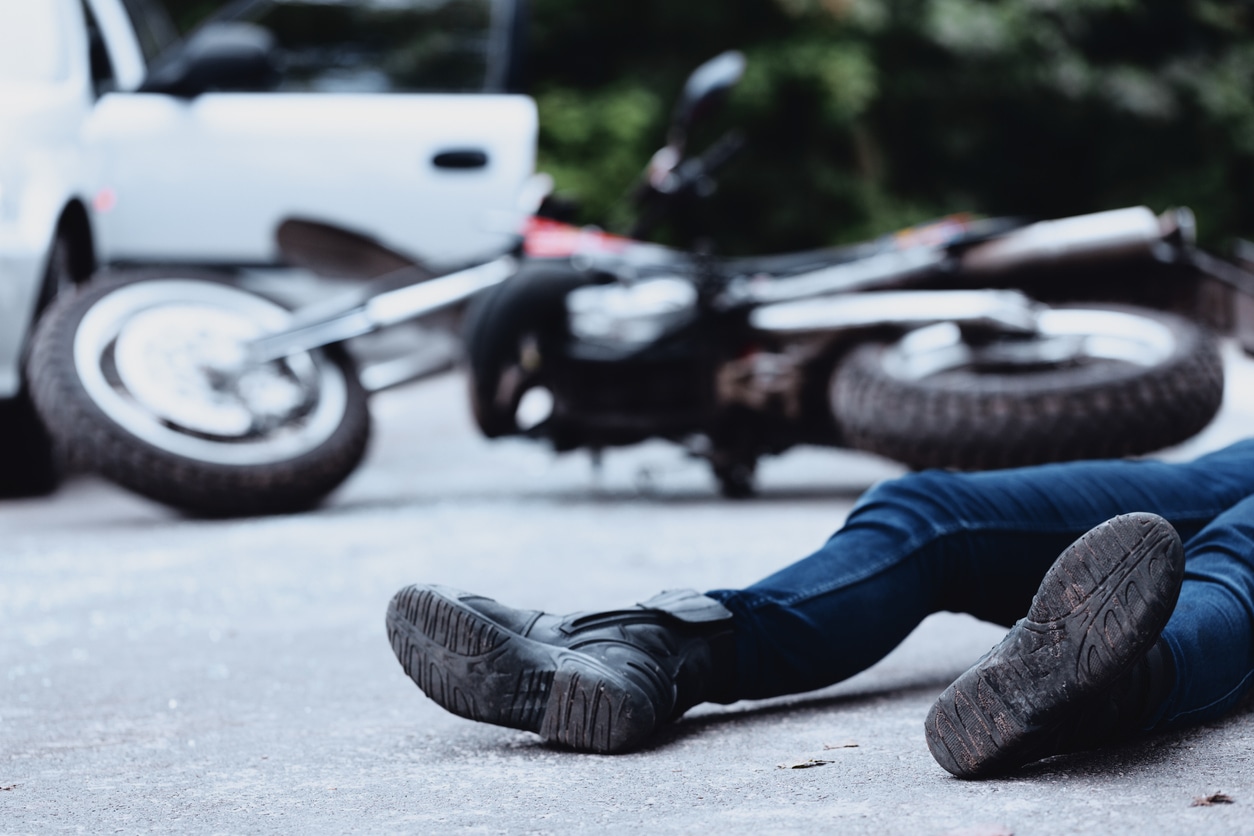Why Are Motorcycle Accidents So Deadly?

Motorcycle accidents are some of the most dangerous and deadly types of vehicle crashes. When a motorcycle collides with a car or truck, the rider has very little protection compared to the occupants of the larger vehicle. This means motorcycle riders are much more likely to suffer severe injuries or even death in an accident.
So why exactly are motorcycle accidents so deadly compared to other types of vehicle crashes? There are a few key reasons, as a motorcycle accident attorney will explain for you here. If you lost a loved one in a fatal crash, consult a dedicated lawyer in your area today.
Lack of Protection
Motorcycle accidents tend to be so severe because riders have very little protection in a crash. In a car, the metal frame, seat belts, airbags, and other safety features help shield occupants from the force of an impact. But on a motorcycle, the rider’s body is completely exposed.
When a motorcycle crashes into another vehicle or object, or if the rider is thrown from the bike, their body absorbs the full force and trauma of the impact. This commonly leads to catastrophic injuries like traumatic brain injuries, spinal cord damage, crushed or amputated limbs, internal organ damage, and more. Sadly, many of these severe injuries prove fatal.
Compared to a car’s protective metal cage, a motorcycle helmet and padded clothing simply can’t provide the same level of collision protection. While proper safety gear is critically important and can certainly save lives, it’s just no match for thousands of pounds of metal smashing into a rider’s body at high speed.
Higher Collision Speed
Motorcycles are smaller, lighter, and more agile than cars and trucks. This allows them to accelerate faster and reach higher speeds more quickly. When traveling at high speeds, riders have less time to react and avoid hazards on the road.
If a crash occurs, the extreme forces generated by the speed make severe or fatal injuries much more likely. Colliding with a larger vehicle or fixed object at 60 to 80 mph or more will almost certainly result in devastating trauma to the rider’s body.
Less Visibility
Another factor that makes motorcycle accidents so dangerous is the smaller visual profile of motorcycles compared to cars and trucks. Many drivers simply don’t see an approaching motorcycle, especially at intersections or when changing lanes. Distracted, drunk, or otherwise negligent motorists may look right past a motorcycle and turn or merge directly into its path.
When another vehicle violates a motorcycle’s right-of-way, the rider may have no time to take evasive action to avoid a collision. A sudden impact from the side can easily send a rider flying off their bike into oncoming traffic, off a bridge, or into roadside trees, poles, guardrails, and other hazards. The resulting injuries are often catastrophic or fatal.
Any driver who fails to pay enough attention and hits a motorcyclist should be responsible for the harm they cause.
Road Hazards
Hazardous road conditions that may be a minor annoyance for cars and trucks can be deadly for motorcycles. Potholes, cracked pavement, railroad tracks, wet leaves, oil slicks, gravel, and road debris can all cause a motorcycle to crash with little warning.
When a motorcycle’s tires lose traction due to uneven or slippery surfaces, it can easily lead to the rider being thrown from the bike. Riders may have to swerve or lay the bike down to avoid a hazard, putting them at risk of sliding under the wheels of another vehicle. When a motorcyclist’s body impacts the hard road surface in a crash, severe head trauma, spinal injuries, and fatal wounds are sadly common.
Often, road hazards are the result of inadequate maintenance by government agencies or negligent construction crews.
No Airbags or Seat Belts
Most modern passenger vehicles are equipped with front and side impact airbags and three-point seat belts to hold occupants securely in place during a crash. These essential safety features can prevent vehicle occupants from being ejected and suffering deadly trauma. They spread out and absorb collision forces that will otherwise be concentrated on the head, neck, and chest.
Motorcycles, of course, have no such safety equipment. Even if a rider is wearing a full-face helmet (which not all states require), their head and neck are still vulnerable to severe whiplash, concussions, skull fractures, and facial injuries in a wreck. Without seat belts, motorcycle riders are commonly thrown clear of their bike in a collision and suffer devastating bodily trauma.
More Likely to Be Hit from Behind
Motorcycles have a much narrower rear profile than cars and trucks, sadly making them more likely to be hit from behind. A distracted driver may not notice that a motorcycle has stopped ahead of them at a light or stop sign until it is too late. When a motorcycle is rear-ended, the rider can be crushed between the vehicles or launched into a deadly high-speed tumble.
Cars also commonly hit motorcycles from behind when a rider is attempting to make a left turn. An impatient driver may try to pass the slowed or stopped motorcycle, colliding with it as the rider turns. This type of broadside impact is especially likely to knock the motorcyclist into oncoming traffic.
Aggressive Driving

Sadly, some drivers exhibit road rage and aggression specifically directed at motorcyclists. Whether out of jealousy of their ability to lane split in traffic, annoyance at motorcycle noise, or a general disregard for riders’ safety, these hostile motorists may intentionally tailgate, cut off, or even try to hit motorcycles.
An aggressive driver’s unexpected sideswipe or dangerous merge can easily send a motorcycle careening out of control. Riders may run off the road or be forced to lay the bike down to reduce the impact. Without the protection of an enclosed vehicle, motorcyclists are extremely vulnerable to severe harm from the criminal negligence of road-raging motorists.
Alcohol Impairment
Impaired drivers of passenger vehicles also pose a serious threat to riders. A motorcycle’s small size and lack of protective enclosure make it much more vulnerable in a collision with a larger vehicle. And sadly, many devastating motorcycle accidents are caused by intoxicated drivers in cars and trucks. An impaired driver behind the wheel of a 4,000-pound car or an 80,000-pound semi-truck can be a deadly weapon for a motorcyclist.
Alcohol affects the brain’s ability to process information and make good decisions. It slows reaction times, decreases coordination, and impairs vision and depth perception. Drunk and drugged drivers are more likely to drift out of their lane, sideswipe a motorcycle, or rear-end a bike stopped in traffic.
They may turn left in front of an oncoming motorcycle or fail to yield the right-of-way at an intersection. Their slower reaction times make it much less likely that they can avoid a crash if they do suddenly encounter a motorcycle in their path.
In short, impaired drivers often exhibit the kind of dangerous behaviors that put motorcyclists’ lives at risk. And even if they see a motorcycle, an intoxicated motorist’s judgment and coordination may be too compromised for them to respond safely in time. The combination of a relatively unprotected rider and a multi-ton vehicle operated by a drunk or drugged driver is often a recipe for disaster.
High Rate of Fatalities
The statistics on motorcycle accident fatalities are truly alarming. While motorcycles account for only a small fraction of the total vehicles on the road and the total miles driven, they are involved in a disproportionately high percentage of traffic deaths. This is a stark reminder of just how vulnerable motorcyclists are in a crash.
When a motorcycle is involved in an accident, the rider’s body is exposed to violent forces that most passenger vehicle occupants are shielded from. Without the protection of airbags, seat belts, and a metal and glass cockpit, the motorcyclist’s body often takes full impact from the collision. Sadly, this means that many riders who are involved in crashes suffer fatal injuries.
Even when a motorcyclist survives the initial trauma of an accident, they are still at much higher risk of dying from their injuries than occupants of a passenger vehicle would be. Severe head injuries, spinal cord damage, and internal bleeding are common in motorcycle crashes, and these types of injuries can quickly turn fatal without immediate medical intervention.
In many cases, even the best protective gear can’t save a rider’s life in a serious wreck. While helmets, armored clothing, and other equipment can certainly help reduce the risk of death or severe injury, they simply can’t provide the same level of protection as a car or truck’s steel cage and advanced safety features. This means that motorcyclists are inherently more likely to suffer deadly wounds in an accident, regardless of what safety precautions they take.
The heartbreaking reality is that many motorcycle accident fatalities are preventable if other motorists are more attentive and cautious around bikes. Too often, negligent drivers fail to watch for motorcycles, yield the right-of-way, or provide adequate space for riders to maneuver. When a careless driver’s mistake leads to a motorcycle crash, the rider pays the ultimate price.
Losing a loved one to a motorcycle accident is an unimaginable tragedy. Families are left shattered, children grow up without a parent, and spouses face a lifetime of grief and financial hardship. The sad truth is that no amount of money can ever truly compensate for the loss of a cherished family member. However, holding negligent drivers accountable can help bring a sense of justice and closure and provide crucial support for families facing an uncertain future.
Wrongful Death Claims from Fatal Motorcycle Crashes
When a family loses a spouse, parent, or child in a fatal motorcycle crash due to someone else’s negligence, they have the right to seek compensation. State laws allow certain family members or the personal representative of the estate to pursue a wrongful death claim, seeking damages for financial and emotional losses.
To succeed in a wrongful death claim, surviving family members must prove the following:
- The liable party owed the motorcyclist a duty of care
- The party breached their duty of care
- The breach caused the fatal injuries
- The family suffered specific losses due to the fatality
Gathering evidence and proving these legal elements to insurance companies or in court can be overwhelming for grieving families. Most people have no idea where to begin. Fortunately, a motorcycle accident attorney can handle every step of the process for you.
You can focus on your emotional state and putting the pieces back together following your devastating loss. Your lawyer will focus on battling insurers and negotiating for the compensation and justice you deserve.
Did Your Loved One Die in a Crash? Call a Motorcycle Accident Attorney

As we’ve seen, motorcycle accidents are often devastating for riders and their loved ones. Severe injuries like head and spinal trauma can often be fatal, leaving families with overwhelming losses. The financial and emotional toll can be an immense burden.
Unfortunately, insurance companies know that motorcycle accidents tend to lead to very high-dollar claims. This leads many insurers to fight tooth and nail to avoid paying fair compensation to the families of deceased riders. They may try to shift blame onto the motorcyclist or pressure families to accept a lowball settlement before they understand the full extent of their rights and losses.
That’s why it’s so important to consult an experienced motorcycle accident lawyer as soon as possible if you lost a loved one in a crash. A skilled attorney can handle all communications with the insurance company and fight for the full compensation you deserve. A motorcycle accident lawyer can gather evidence, interview witnesses, and build a strong case to prove the other party’s negligence and liability for your tragic loss.
Most motorcycle accident lawyers work on a contingency fee basis, which means you pay nothing upfront and only owe a fee if they win money for you. So don’t wait to get the legal advocacy you need after a fatal motorcycle wreck. Call a personal injury attorney today for a free consultation and get started on the road to justice.
